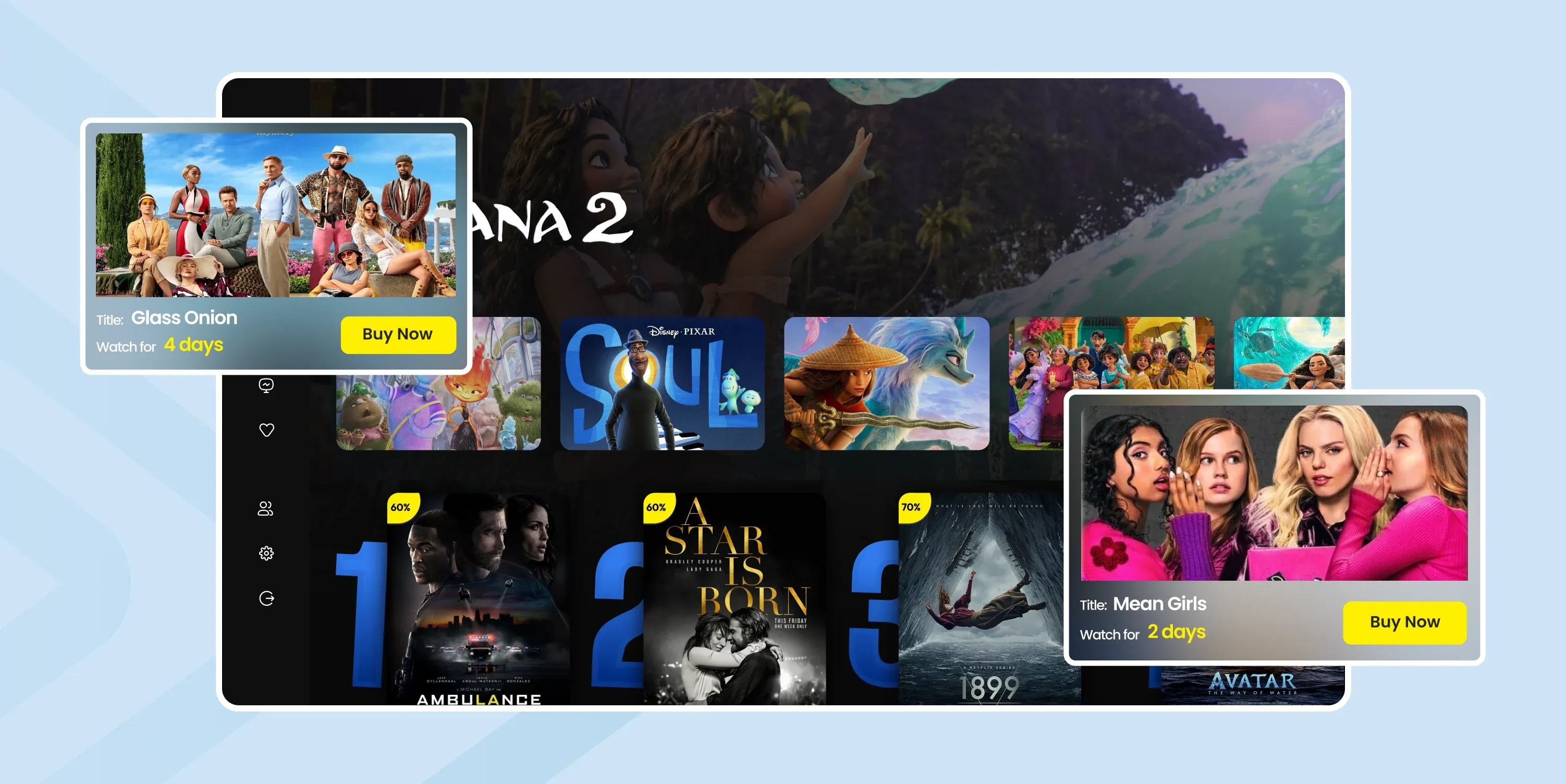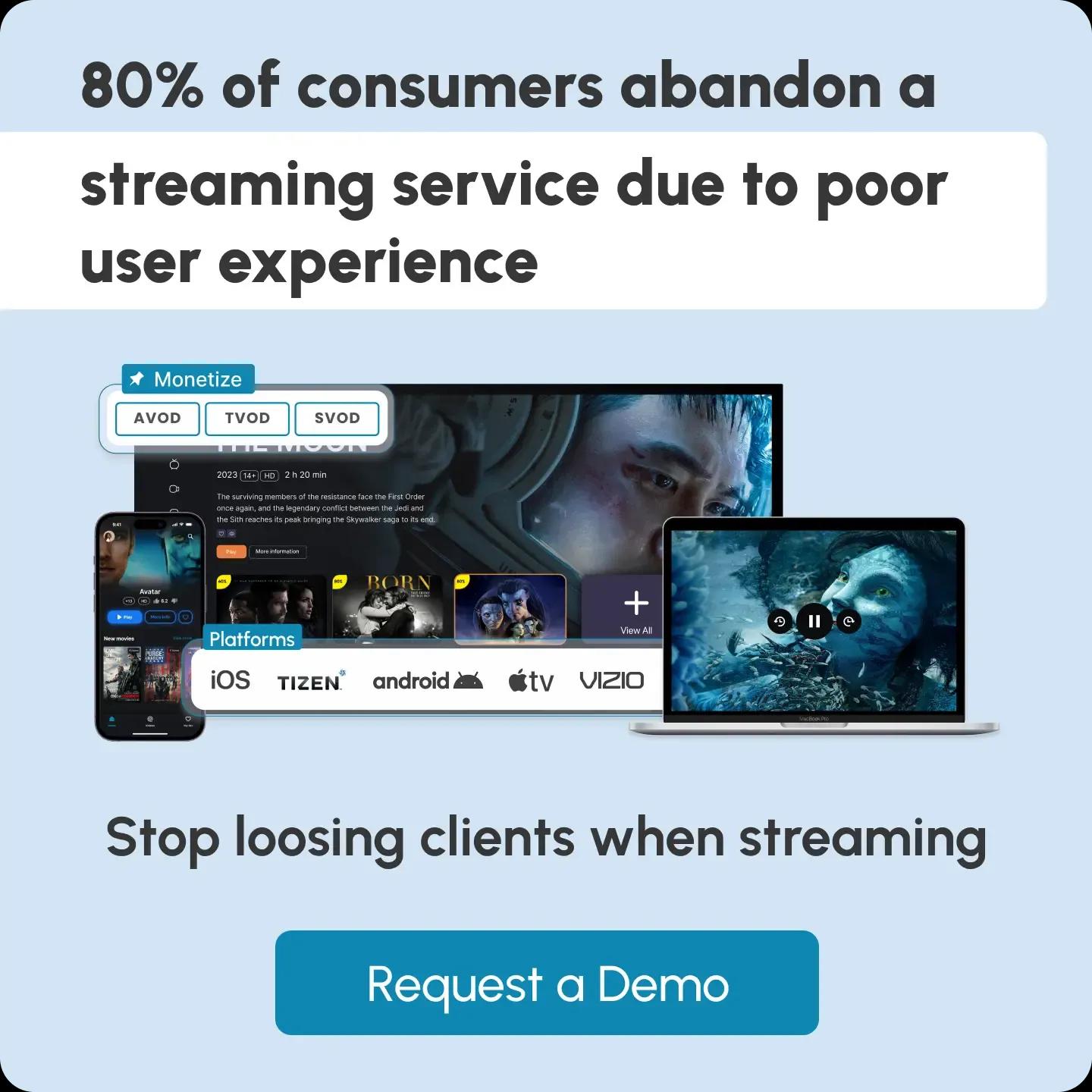
What is Pay Per View (PPV) Streaming? Benefits and Monetization
Many assume that running in-stream ads is the best way to monetize video content, but pay-per-view streaming is quickly proving to be a more effective and profitable model.
So, what is pay-per-view, how does it work, and do you need it?
Read on to find out.

Key Takeaways
- With pay-per-view streaming, viewers pay to access specific content, usually for a limited time.
- Pay-per-view is widely used for live events like sports, concerts, and exclusive broadcasts.
- The Pay-per-view model allows creators to charge per event, providing a direct revenue stream.
- Pay-per-view attracts viewers who prefer one-time purchases over long-term subscriptions.
- Pay-per-view content is often exclusive, encouraging higher audience engagement and interest.
What is Pay-Per-View?
Pay-Per-View (pay-per-view) is a content distribution model where viewers pay a one-time fee to watch a specific event, movie, or show. So, the user can buy or rent the exact video content they want to watch (no subscription needed).
Pay-per-view began as a cable and satellite television service where viewers paid to watch certain events like boxing matches or live concerts.
To understand the concept of Pay-Per-View, here is a table showing its evolution:
| Era | Key Developments |
|---|---|
| Early Beginnings (1940s–1950s) | - Zenith Phonevision (1940s) tested ordering TV content via telephone lines but was shut down by the FCC. - Telemeter (1950s) offered first-run movies and sports via coin-operated TV boxes but faced legal issues. |
| Cable Era & Commercial Launch (1970s–1980s) | - Channel 100 (1972) introduced one of the first cable-based pay-per-view systems in San Diego. - Sugar Ray Leonard vs. Thomas Hearns fight (1981) brought pay-per-view into mainstream attention. - Dedicated pay-per-view channels like Viewers Choice and Request TV launched, expanding offerings to movies, concerts, and sports. |
| Mainstream Growth (1990s) | - Networks like HBO and Showtime popularized pay-per-view for blockbuster movies and major sporting events. - Pay-per-view streaming saw increased adoption, paving the way for digital models. |
| Modern Evolution (2000s–Present) | - Video-on-Demand (VOD) gained popularity, providing more flexibility for viewers. - Pay-per-view transitioned into the digital realm with online platforms like YouTube, Dacast, and Vimeo. - OTT platforms enabled global monetization of live and on-demand content, boosting pay-per-view for events like UFC fights, boxing, and major entertainment broadcasts. |
How Does Pay-Per-View Work?
Pay-per-view streaming allows users to access exclusive content for a one-time fee. Creators or broadcasters select the media they want to offer—anything from live sports and concerts to on-demand content like premiering movies—and set a price for viewers to watch.
This price is typically higher than a standard rental or subscription, reflecting the unique or exclusive nature of the event.
After purchasing, viewers receive a code or link to access and stream the content. In this process, security is key. pay-per-view streaming services typically use encryption to ensure only those who’ve paid can access the content. This keeps the content safe and prevents unauthorized sharing.
Most pay-per-view platforms have built-in paywalls to handle payments. This lets creators earn directly from their audience without relying on ads.
There’s flexibility in how long you get access to the content with a one-time fee. Some pay-per-view streaming services offer content rentals for a set time, while others let you buy it for unlimited access.
Today, the pay-per-view model is thriving, especially for live pay-per-view streaming and premium content. It’s secure, flexible, and a great way for creators to earn from their content.
If you want to stream content with a pay-per-view(Pay-Per-View) model, inoRain is here to help! Contact us to get started!
Key Features of Pay-Per-View Streaming Platforms
A well-structured pay-per-view streaming platform has key features as its cornerstones. Let’s take a look at the main ones.
Content Management
A solid content management system (CMS) includes tools for organizing, categorizing, and sharing content, ensuring everything is easy to find. A well-designed CMS makes it simpler for creators to upload and schedule content, keeping things running like clockwork.
Accessibility and Device Compatibility
A great pay-per-view platform should be accessible to everyone. That means supporting features like closed captions, audio descriptions, and adjustable playback options for users with disabilities.
As more people stream, the platform must work flawlessly across various devices (smartphones, TVs, tablets, etc.), ensuring a seamless experience no matter what device the viewer is using.
Monetization
Pay-per-view platforms offer flexible monetization tools. This could include options like selling tickets to live streaming pay-per-view events, offering on-demand content for a fee, or even enabling additional income streams like sponsored content.
Advanced platforms offer dynamic pricing, tailored ads, or integrated e-commerce features to boost revenue.
Analytics
Understanding your audience is essential, and that’s where analytics come in. Pay-per-view streaming services offer detailed insights into viewer behavior, demographics, and engagement. With this data, creators can refine their content strategies, improve recommendations, and optimize marketing efforts.
Knowing what works—and what doesn’t—helps maximize profits and keeps viewers satisfied.
Benefits of Pay-Per-View
Instead of paying for a complete cable package or an OTT subscription, viewers pay only for the content they want to watch. So, pay-per-view is a versatile, straightforward way to access content without the need for long-term commitments.
Let’s look at the table below to understand how beneficial pay-per-view can be for you and also your end-user.
| Benefit | For Content Creators | For Viewers |
|---|---|---|
| Instant Revenue | Get immediate earnings from pay-per-view purchases | No need to commit to ongoing fees—just pay for specific content |
| Flexible Pricing | Set prices based on exclusivity or demand | Choose what to pay for based on interest and budget |
| Global Accessibility | Reach international audiences without geographical limits | Access exclusive events worldwide, without location restrictions |
| Higher Viewer Interest | Paying audiences are more engaged and invested | Exclusive content creates a premium viewing experience |
| Security Against Piracy | Many platforms offer DRM and paywalls to protect content | Secure and authorized access ensures high-quality streams |
| High-Quality Streaming | Deliver HD or 4K streams for a premium experience | Enjoy high-quality, uninterrupted viewing |
| Flexible Content Formats | Works for live, on-demand, or hybrid events | Watch live or access replays at their convenience |
| No Interruptions | Provide a clean, focused content experience | No ads disrupting the viewing experience |
| Personalized Viewing | Customize pricing, branding, and accessibility settings | Features like subtitles, multiple languages, and playback control |
| Viewer Engagement Tools | Use live chats, polls, or Q&As to boost engagement | Participate in interactive features like live discussions |
Monetization with pay-per-view Services
There are plenty of ways for content creators to make money using pay-per-view streaming.
 Here are the three main ways you can monetize your content with pay-per-view:
Here are the three main ways you can monetize your content with pay-per-view:
1. Live Stream Shopping
If you haven’t come across it yet, this is where creators combine social media, live video, and e-commerce to sell products in real-time. It’s like a modern version of home shopping networks, but way more interactive and engaging. By showcasing your products live and interacting with viewers, you can boost sales and keep your audience hooked.
2. Advertising
Another solid way to profit from pay-per-view events is through advertising. Whether hosting a live pay-per-view streaming event or offering on-demand content, ads can be easily incorporated. Pre-rolls, mid-rolls, and end-rolls—those short ads before, during, or after the stream—are a great way to generate extra income.
3. Collaborations
Collaborating with other creators, companies, or sponsors is another big opportunity. If you have a decent following, you can attract brands and sponsors eager to promote on your live streams or featured content. Partnerships can open up new revenue streams and expand your reach, making it a win-win for everyone involved.
And if you’re an educator or influencer, pay-per-view is a fantastic way to monetize your expertise. You can host live classes or workshops, selling tickets to viewers who want to learn from you. With the right tools, handling all the behind-the-scenes admin work becomes easier, allowing you to focus on creating content and growing your audience.
inoRain can help you with all the things above. Contact us to learn more!
Pay-Per-View Challenges and Solutions
While pay-per-view is a great way to monetize content, it comes with its own set of challenges. Let’s dive into a few key obstacles and how they impact pay-per-view streaming.
Piracy
One of the most significant challenges for pay-per-view is piracy. Unauthorized streams can significantly impact revenue, especially for high-profile events.
Solution: Platforms must invest in strong security measures like DRM to protect their content.
Standing Out in a Crowded Market
With so much content available online, grabbing attention is harder than ever. Simply put, if you’re not offering something special, it’s tough to compete.
Solution: Offer high quality, engaging content. Make discounts and special offers, especially for loyal users, to encourage further interactions.
Tracking
Tracking the performance of pay-per-view campaigns used to be simpler, but now it’s a lot more complex. With more conversion tools and tracking methods available, marketers need to be proactive in understanding their metrics. Getting accurate data is crucial for making smart decisions and refining strategies.
Solution: Invest in strong and automated analytics integration to decrease the manual tracking.
Technical Issues
Live pay-per-view streaming has its fair share of technical hiccups. Problems like buffering, latency, or even outages can seriously frustrate viewers and lead to refund requests.
Solution: Use a reliable CDN (Content Delivery Network) and ABR (Adaptive Bitrate) to minimize the downtime and latency.
OTT Platforms and Pay-Per-View Integration
Integrating pay-per-view (pay-per-view) into an OTT platform is a popular way for enterprises to generate additional income. But it requires several key components to ensure smooth content delivery and secure monetization. Let’s take a look.
Scalable Cloud Infrastructure
A big part of pay-per-view integration is scaling smoothly. As more people tune in—especially during live events—platforms need to handle the sudden traffic without missing a beat. This is where cloud-based infrastructure steps in, automatically adjusting to ensure viewers have a seamless streaming experience, no matter how many are watching.
Dynamic Pricing Models
OTT platforms are getting smart with dynamic pricing. Prices can change based on demand, early bird offers, or the type of event. This flexibility gives creators more ways to increase revenue and offer better value to their audience.
Search and Recommendations
Good pay-per-view integration means having strong search tools and smart recommendations, making it easy for viewers to discover niche pay-per-view live streaming events or big-ticket content without getting lost.
Interactive Social Features
More OTT platforms are adding features like live chats, watch parties, and social sharing. These interactive elements create a buzz around the event, helping it spread and keeping viewers engaged longer.
If you read this far, there is a high chance you want to get a pay-per-view model, so, we offer what you need. Contact us to get your scalable, easy-to-use, and personalized OTT solution with a pay-per-view integration today.
Conclusion
Pay-Per-View (pay-per-view) is a dynamic content distribution model that benefits both creators and viewers. Whether it's a live sports event, a concert, or an exclusive webinar, pay-per-view streaming allows you to unlock new revenue streams while giving audiences access to premium, personalized content.
So, pay-per-view is the perfect solution for you if you are looking to engage your audience, monetize content, and do this without subscription tiers.
FAQs
What does pay-per-view mean?
Pay-per-view means viewers are charged for individual pieces of content, like a movie or live sports event, rather than paying for a broader subscription. You get to choose what you want to watch and pay for only that content.
Which platforms offer pay-per-view streaming?
Several platforms support pay-per-view streaming, including popular options like Dacast, Vimeo, Kaltura, Muvi, Uscreen, and even YouTube.
How can I stream my pay-per-view content?
To stream your own pay-per-view, simply choose a platform, create an account, set your pricing, promote your event, and launch the stream. If you’re looking for a custom solution, you can also build your own OTT platform with inoRain to offer tailored pay-per-view streaming services.
Can pay-per-view be combined with subscription models?
Yes, many platforms offer a hybrid model where subscribers can purchase pay-per-view content at a discounted rate or gain early access to events.
Is pay-per-view only for live events?
No, while pay-per-view is popular for live events, it can also be used for on-demand content such as movies, special series, or documentaries.
What is a pay-per-view schedule?
A pay-per-view schedule is a list of upcoming events or shows available for pay-per-view. It usually includes details such as event times, prices, and access options.
How much is pay-per-view?
The cost of pay-per-view streaming varies depending on the type of content and platform. For major events like boxing matches or concerts, prices can range anywhere from $10 to $100 or more. Smaller, on-demand pay-per-view content often costs less.
Co-founder / CTO
Armen is the CTO and Co-Founder of inoRain OTT and Co-Founder of HotelSmarters, specializing in advanced streaming technologies, OTT strategy, and interactive TV systems. He builds scalable end-to-end video delivery solutions and drives technical innovation across hospitality and streaming platforms, bridging complex engineering with practical business impact.

OTT Advertising: Types, Best Practices, and Strategies
Over-the-top (OTT) advertising has transformed how brands connect with consumers.

VPlayed Alternatives: inoRain vs. VPlayed
Explore inoRain as a VPlayed alternative, comparing features, pricing, and OTT solutions to find the best platform for your streaming needs.

Custom OTT Platform Development: How to Start an OTT Business
This guide will walk you through everything you need to know about the OTT platform development.

